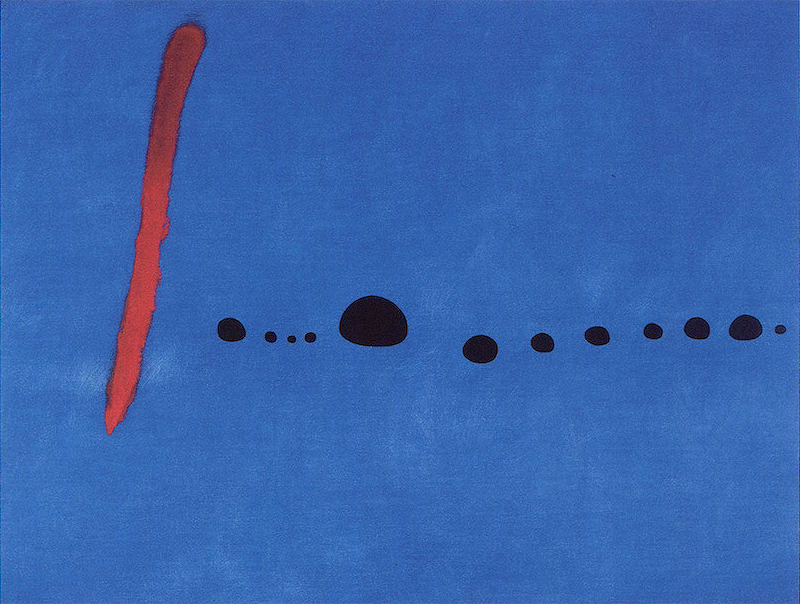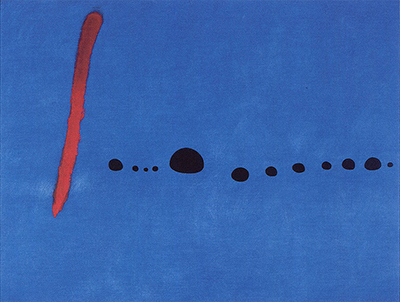As the middle painting in a group of three, Bleu II by Joan Miro is a striking piece. It was painted when Miro was already popular and holding many exhibitions, and attracts a lot of attention based on the bright colours and unusual shapes.
Bleu II is joined by Bleu I and Bleu III to create what is known as a triptych of paintings. They are displayed together, and are much bigger than one might expect; they each measure over three metres by two metres. Today they are owned by a Paris museum called Musée National d'Art Moderne. Bleu II carries the same rich blue hue as the other two, with a slash of red and small seemingly random black dots along it. Many of Joan Miro's paintings focused on similar blues. The colour is rich and attention-grabbing, but that is not the reason he swayed so heavily toward this hue. Miro believed the colour to have an importance that other colours did not, and he associated it with a surreal, dream-like night. Inspired by cubism that was growing in popularity at the time, Miro combined his use of this colour with an inventive use of shapes and forms to create art that continues to be held in high regard today.
Joan Miro was already very popular at the point of painting this triptych which gave him the freedom to express his ideas and intentions without worrying about how it would be taken by the public. Bleu II and its two companion paintings could be seen as summing up Joan Miro's work up until that point, with the themes found elsewhere coming to pass once again in these paintings without being a mindless repeat on a theme. If looking at Bleu II gives you a sense of solitude, that is not unexpected. Joan Miro held a deep fascination with empty spaces, and in Bleu II the use of shapes in the blue expanse only manages to accentuate the bareness of the painting. Miro's interest in empty spaces is compelling, especially when presented in a way that seems inventive so many years after the painting was completed.
It could be a wide blue sky at dusk or a wide ocean under the sunlight. The openness of the painting along with its simplicity gives the viewer every chance to understanding the painting themselves without prejudice, and it is easy indeed to project your own ideas into a canvas that was intentionally left with the potential for lots of space. Miro gives the viewer breathing room to bring their own interpretation to the canvas alongside the rich colours and unusual forms, and that makes him special. The randomness of the shapes is not artificial. One of the most interesting things about the way Joan Miro created his paintings is that he did not attempt to keep control over his motions in a way that some painters and other artists do. Miro has no interest in the conscious creations, but instead would rather reach his subconscious to create his art.
Due to this, he claimed to let his hand wander when he was painting, not thinking through every piece but instead just going with whatever felt right in the moment. This free, expressive habit gave Joan Miro an edge not always found in other artists of his time. Miro experimented with the subconscious and created compelling art in the meantime. By opening up his art and letting the viewer bring their own understanding along with them, he created Bleu II and its fellow paintings and ensured they would not be forgotten in the passage of time.





